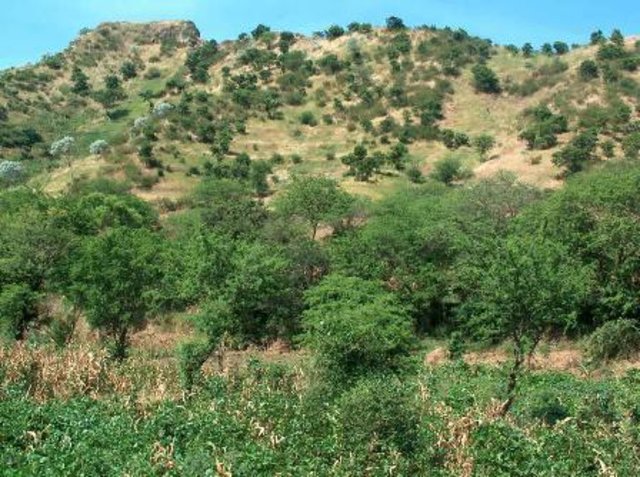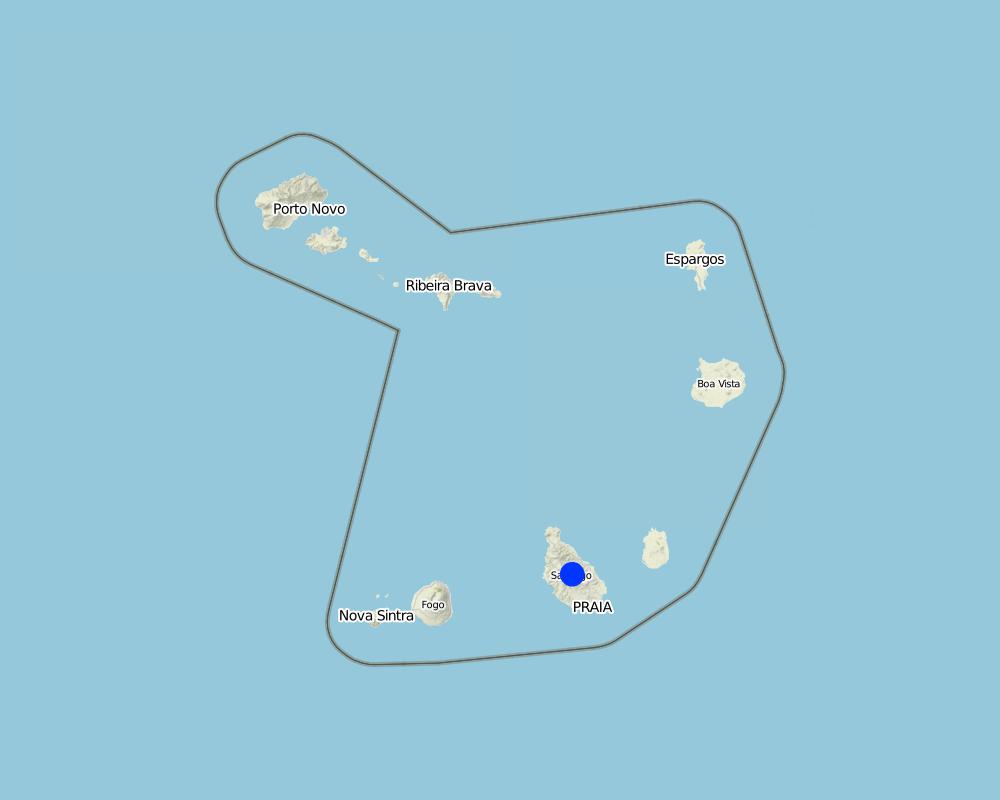Reforced terraces for stone walls [佛得角]
- 创建:
- 更新:
- 编制者: Jacques Tavares
- 编辑者: –
- 审查者: Fabian Ottiger, Alexandra Gavilano
Terraços reforçados por murros de pedra
technologies_1573 - 佛得角
查看章节
全部展开 全部收起1. 一般信息
1.2 参与该技术评估和文件编制的资源人员和机构的联系方式
SLM专业人员:
Gomes Samuel
INIDA
佛得角
SLM专业人员:
Varela Larissa
INIDA
佛得角
SLM专业人员:
Bentub Jailson
INIDA
佛得角
有助于对技术进行记录/评估的机构名称(如相关)
INIDA (INIDA) - 佛得角1.3 关于使用通过WOCAT记录的数据的条件
编制者和关键资源人员接受有关使用通过WOCAT记录数据的条件。:
是
1.4 所述技术的可持续性声明
这里所描述的技术在土地退化方面是否存在问题,导致无法被认为是一种可持续的土地管理技术?:
否
1.5 参考关于SLM方法(使用WOCAT记录的SLM方法)的调查问卷

Arborisation [佛得角]
None
- 编制者: Jacques Tavares
2. SLM技术的说明
2.1 技术简介
技术定义:
Platforms created in series along the slopes, separated by punch of stone, vertical, reduced the length of slopes and facilitating the infiltration of water and increasing production
2.2 技术的详细说明
说明:
The terraces, platforms are created on the slopes, where the slope exceeds 30, to reduce or eliminate the gradient of the slope, creating an agricultural field with better soil fertility. Such platforms have 5% inclination to the inside retaining more water to its surface, and 1% of the drainage along facit, in case of saturation of soil in water. The separation between two platforms is performed by punches from the local stone, that structure has to be calculated, taking into cosideração the slope of the slope, the width of the platform, edefoclimáticas conditions and other variables.
Its primary objective is to adapt the land to use it intends to take to eliminate the slope of the hill, working to increase soil moisture, the reduction of runoff, and its kinetic energy through the punches
Implementation: Need wide availability of labor and large technical training for its implementation. The activity of implementation requires the calculation of the volume of soil to be moved, thus defining the width of the platform, this volume that depends crucially on the thickness of surface horizon soil. In some regions where there are avenues of access to machines, the platform is done by tractors, others are made by hand. The construction of the punch, requiring stone and labor requires high technical capacity in both dimensions of the foundation as part of the whole structure.
Natural / human environment: Built in soils of agricultural vocation of medium texture, mostly in areas of regadioem that the irrigation system requires that the area is flat, sub-humid areas and semi-arid. Hillsides with slopes greater than 20%
It is a measure purely structural: Great movement of earth, made with hand tools and / or machines. The production in these areas is subsistence or mixed. This measure is carried out mainly in areas where the land user is owner
2.5 已应用该技术的、本评估所涵盖的国家/地区/地点
国家:
佛得角
区域/州/省:
Santiago
有关地点的进一步说明:
Praia
具体说明该技术的分布:
- 均匀地分布在一个区域
如果技术均匀分布在一个区域,则指定覆盖的区域(单位为平方千米):
14.0
注释:
Total area covered by the SLM Technology is 14 km2.
It's presence is most import in sous bassins of Pico da Antónia and Longueira
Map
×2.6 实施日期
如果不知道确切的年份,请说明大概的日期:
- 10-50年前
2.7 技术介绍
详细说明该技术是如何引入的:
- 在实验/研究期间
注释(项目类型等):
The first structures were construdas in 1978 in St. George, which was an action of FAIMO project
3. SLM技术的分类
3.1 该技术的主要目的
- 改良生产
- 减少、预防、恢复土地退化
- 创造有益的经济影响
3.2 应用该技术的当前土地利用类型

农田
- 一年一作
年作 - 具体指明作物:
- 谷物类 - 玉米
- 豆科牧草和豆类 - 豆子
每年的生长季节数:
- 1
具体说明:
Longest growing period in days: 90, Longest growing period from month to month: Aug - Oct
注释:
Major cash crop: Horticulture
Major food crop: Maize and beans
Major land use problems (compiler’s opinion): The loss of soil by runoff, influenced by its low coverage, reducing their fertility and their thickness
Major land use problems (land users’ perception): The loss of soil by runoff, low productive soils, low organic matter
3.4 供水
该技术所应用土地的供水:
- 雨养
注释:
Water supply: Also mixed rainfed - irrigated
3.5 该技术所属的SLM组
- 横坡措施
3.6 包含该技术的可持续土地管理措施

结构措施
- S6:墙、障碍物、栅栏、围墙
- S11:其它
3.7 该技术强调的主要土地退化类型

土壤水蚀
- Wt:表土流失/地表侵蚀
- Wg:冲沟侵蚀/沟蚀

物理性土壤退化
- Pu:由于其他活动而导致生物生产功能的丧失
注释:
Main causes of degradation: soil management (It is cultivated maize and peanuts on land slopes very pronounced and boot), crop management (annual, perennial, tree/shrub) (At the end of each cycle of cultivation of maize, the most prevalent, the crop residues are deracinate, leading to the loss of soil cover), droughts (ocorrem secas cíclicas nesse país, sendo a mais marcante, a de 1947)
Secondary causes of degradation: overgrazing (Creation of the wild animals compact the soil, destroying the structures for the conservation of soil and water exists, and creates conflict), disturbance of water cycle (infiltration / runoff) (A fraca cobertura vegetal não favorece a infiltração da água quando chove, principalmenThe low vegetation cover, does not favor the infiltration of water when it rains, especially where there are crus), Heavy / extreme rainfall (intensity/amounts) (Sometimes heavy intensity rains that occur associated with poor vegetation cover and increase soil erosion)
3.8 防止、减少或恢复土地退化
具体数量名该技术与土地退化有关的目标:
- 防止土地退化
4. 技术规范、实施活动、投入和成本
4.1 该技术的技术图纸
技术规范(与技术图纸相关):
Terraces in São Jorge. It shows the slope of the estruture
Location: Praia. Cabo Verde
Technical knowledge required for field staff / advisors: high (The infrastructure has a certain risk to be reduced to the maximum, based on a design, the more accurate possible. And that takes into account the greater number of variables)
Technical knowledge required for land users: moderate (Must have sufficient knowledge to understand and assimilate the technical guidance.)
Main technical functions: reduction of slope angle, reduction of slope length, sediment retention / trapping, sediment harvesting
Secondary technical functions: control of dispersed runoff: retain / trap, increase of infiltration
Wall/ barrier
Vertical interval between structures (m): 1.5-2.5
Spacing between structures (m): 10-15
Construction material (earth): A terra usada é local. A terra extraida da escavação é usada nos pontos do aterro
Construction material (stone): it´s used to make a wall, end it's taked in the local
Slope (which determines the spacing indicated above): 30-60%
If the original slope has changed as a result of the Technology, the slope today is: 50%
Lateral gradient along the structure: 1%
Specification of dams/ pans/ ponds: Capacity 1200m3
Catchment area: 600m2m2
Beneficial area: 600m2m2
Slope of dam wall inside: 200%;
Slope of dam wall outside: 170%
For water harvesting: the ratio between the area where the harvested water is applied and the total area from which water is collected is: 1:1
4.2 有关投入和成本计算的一般信息
其它/国家货币(具体说明):
ECV
如相关,注明美元与当地货币的汇率(例如1美元=79.9巴西雷亚尔):1美元=:
80.0
注明雇用劳工的每日平均工资成本:
6.25
4.3 技术建立活动
| 活动 | 时间(季度) | |
|---|---|---|
| 1. | Leveling the terrain | April |
| 2. | Construction of the batter | June |
4.4 技术建立所需要的费用和投入
| 对投入进行具体说明 | 单位 | 数量 | 单位成本 | 每项投入的总成本 | 土地使用者承担的成本% | |
|---|---|---|---|---|---|---|
| 劳动力 | Labour | ha | 1.0 | 687.5 | 687.5 | 100.0 |
| 设备 | Total | ha | 1.0 | 375.0 | 375.0 | |
| 施工材料 | Total | ha | 1.0 | 875.0 | 875.0 | |
| 技术建立所需总成本 | 1937.5 | |||||
| 技术建立总成本,美元 | 24.22 | |||||
注释:
Duration of establishment phase: 2 month(s)
4.6 维护/经常性活动所需要的费用和投入(每年)
注释:
Machinery/ tools: picareta, enchada, martelo, nível,
5. 自然和人文环境
5.1 气候
年降雨量
- < 250毫米
- 251-500毫米
- 501-750毫米
- 751-1,000毫米
- 1,001-1,500毫米
- 1,501-2,000毫米
- 2,001-3,000毫米
- 3,001-4,000毫米
- > 4,000毫米
农业气候带
- 潮湿的
- 半湿润
- 半干旱
- 干旱
Thermal climate class: tropics
5.2 地形
平均坡度:
- 水平(0-2%)
- 缓降(3-5%)
- 平缓(6-10%)
- 滚坡(11-15%)
- 崎岖(16-30%)
- 陡峭(31-60%)
- 非常陡峭(>60%)
地形:
- 高原/平原
- 山脊
- 山坡
- 山地斜坡
- 麓坡
- 谷底
垂直分布带:
- 0-100 m a.s.l.
- 101-500 m a.s.l.
- 501-1,000 m a.s.l.
- 1,001-1,500 m a.s.l.
- 1,501-2,000 m a.s.l.
- 2,001-2,500 m a.s.l.
- 2,501-3,000 m a.s.l.
- 3,001-4,000 m a.s.l.
- > 4,000 m a.s.l.
5.6 应用该技术的土地使用者的特征
生产系统的市场定位:
- 生计(自给)
- 混合(生计/商业)
非农收入:
- > 收入的50%
相对财富水平:
- 贫瘠
- 平均水平
个人或集体:
- 个人/家庭
机械化水平:
- 手工作业
- 机械化/电动
性别:
- 女人
- 男人
说明土地使用者的其他有关特征:
Land users applying the Technology are mainly common / average land users
Population density: 100-200 persons/km2
Annual population growth: > 4%
Off-farm income specification: the land users who practice the technique, get more income with agricultural production, invest more in their production
Market orientation: Mixed (ranked 1, it is intended to take advantage of the technique, getting more income) and subsistence (ranked 2)
5.7 应用该技术的土地使用者使用的平均土地面积
- < 0.5 公顷
- 0.5-1 公顷
- 1-2 公顷
- 2-5公顷
- 5-15公顷
- 15-50公顷
- 50-100公顷
- 100-500公顷
- 500-1,000公顷
- 1,000-10,000公顷
- > 10,000公顷
这被认为是小规模、中规模还是大规模的(参照当地实际情况)?:
- 小规模的
注释:
Those who practice this technique are those with larger parcel of land
5.8 土地所有权、土地使用权和水使用权
土地所有权:
- 州
- 个人,有命名
土地使用权:
- 个人
用水权:
- 社区(有组织)
5.9 进入服务和基础设施的通道
健康:
- 贫瘠
- 适度的
- 好
教育:
- 贫瘠
- 适度的
- 好
技术援助:
- 贫瘠
- 适度的
- 好
市场:
- 贫瘠
- 适度的
- 好
能源:
- 贫瘠
- 适度的
- 好
道路和交通:
- 贫瘠
- 适度的
- 好
金融服务:
- 贫瘠
- 适度的
- 好
6. 影响和结论性说明
6.1 该技术的现场影响
社会经济效应
生产
作物生产
木材生产
土地管理
收入和成本
农业投入费用
农业收入
工作量
社会文化影响
食品安全/自给自足
文化机会
娱乐机会
冲突缓解
社会经济弱势群体的情况
生态影响
水循环/径流
水的回收/收集
地表径流
多余水的排放
土壤
养分循环/补给
生物多样性:植被、动物
害虫/疾病控制
减少气候和灾害风险
风速
6.3 技术对渐变气候以及与气候相关的极端情况/灾害的暴露和敏感性(土地使用者认为的极端情况/灾害)
渐变气候
渐变气候
| 季节 | 增加或减少 | 该技术是如何应对的? | |
|---|---|---|---|
| 年温度 | 增加 | 好 |
气候有关的极端情况(灾害)
气象灾害
| 该技术是如何应对的? | |
|---|---|
| 局地暴雨 | 不好 |
| 局地风暴 | 好 |
气候灾害
| 该技术是如何应对的? | |
|---|---|
| 干旱 | 好 |
水文灾害
| 该技术是如何应对的? | |
|---|---|
| 比较和缓的(河道)洪水 | 好 |
其他气候相关的后果
其他气候相关的后果
| 该技术是如何应对的? | |
|---|---|
| 缩短生长期 | 好 |
6.4 成本效益分析
技术收益与技术建立成本相比如何(从土地使用者的角度看)?
短期回报:
消极
长期回报:
积极
技术收益与技术维护成本/经常性成本相比如何(从土地使用者的角度看)?
短期回报:
积极
长期回报:
非常积极
注释:
There is any maintenance operation
6.5 技术采用
如若可行,进行量化(住户数量和/或覆盖面积):
144 families and 100% of the area covered
在所有采用这项技术的人当中,有多少人是自发的,即未获得任何物质奖励/付款?:
- 51-90%
注释:
40% of land user families have adopted the Technology with external material support
60 land user families have adopted the Technology with external material support
Comments on acceptance with external material support: They were covered in the course of projects, and port as a mirror for others. Were the first to adopt the technique.
60% of land user families have adopted the Technology without any external material support
84 land user families have adopted the Technology without any external material support
Comments on spontaneous adoption: The technique has proved efficient in increasing the production and adoption, for who had the economic power for its implementation, was significant
There is a moderate trend towards spontaneous adoption of the Technology
Comments on adoption trend: The high cost of technology, makes the poor farmers, unable to adopt. But with any credit or allowance, they take the technology.
6.7 该技术的优点/长处/机会
| 编制者或其他关键资源人员认为的长处/优势/机会 |
|---|
| Mitigation of erosion by reducing the cinetic of runoff and the slope |
| Availability of lands for agriculture |
| Improve of production |
7. 参考和链接
7.1 信息的方法/来源
- 实地考察、实地调查
- 与土地使用者的访谈
7.2 参考可用出版物
标题、作者、年份、ISBN:
Field Guide_DESIRE_Cape Verde, INIDA, 2008
可以从哪里获得?成本如何?
Livrary of INIDA
标题、作者、年份、ISBN:
Conservação do solo e água_Cabo Verde, Antonio Sabino, 1991
可以从哪里获得?成本如何?
Livrary of INIDA_CFA
标题、作者、年份、ISBN:
Técnicas de conservação de solo e água em Cabo Verde_MPAR & CILSS, 1994
可以从哪里获得?成本如何?
Livrary of INIDA_CFA
标题、作者、年份、ISBN:
Conservação do solo e água_Cabo Verde, Antonio Sabino, 1984
可以从哪里获得?成本如何?
Livrary of INIDA
7.3 链接到网络上的相关信息
标题/说明:
QUIBB_INE, 2007
URL:
www.ine.cv
链接和模块
全部展开 全部收起链接

Arborisation [佛得角]
None
- 编制者: Jacques Tavares
模块
无模块


